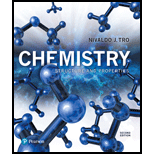
Concept explainers
What is electronegativity? What are the periodic trends in electronegativity?
To determine: Definition of electronegativity and periodic trends in electronegativity.
Answer to Problem 1E
Solution:
Electronegativity is the tendency of an element to attract electrons.
In the periodic table, electronegativity increases along a period and decreases down a group.
Explanation of Solution
Electronegativity is a chemical property of some elements (like oxygen, nitrogen etc.), due to which an atom has the tendency to attract shared pair of electrons towards itself. This results in unequal distribution of electrons.
In the modern periodic table, elements are arranged in order of their increasing atomic number. For this reason, along a period, more and more electrons are added from left to right. As a result, the distance between the nucleus and valence electrons decreases. This increases the electronegativity.
However, down the groups, more and more electronic shells are added due to increase in atomic numbers. As a result, the distance between the nucleus and valence electrons increases. For this reason, electronegativity decreases down the group.
Example:
Electronegativity of oxygen is less than fluorine although both are Period 2 elements.
Electronegativity gradually decreases down group VII because the electronegativity of chlorine is less than fluorine although both elements belong to group VII.
Conclusion:
The electronegativity increases along a period and decreases down a group.
Want to see more full solutions like this?
Chapter 5 Solutions
Chemistry: Structure and Properties - Modified MasteringChemistry
- • define electronegativity and state how electronegativity varies with position in the periodic table.arrow_forward7.29 When two atoms with different electronegativities form a covalent bond, what does the electron distribution in the bond look like?arrow_forward7.26 How is electronegativity defined?arrow_forward
- hy is there an octet rule (and what does actet mean) in writing Lewis structures?arrow_forwardWrite the Lewis structure for nitrosyl fluoride, FNO. Using only a periodic table, identify (a) which is the longer bond. (b) which is the stronger bond. (c) which is the more polar bond.arrow_forwardAspirin is made from salicylic acid, which has this Lewis structure: (a) Which is the longest carbon-carbon bond? (b) Which is the strongest carbon-oxygen bond? (c) Draw resonance structures for this molecule.arrow_forward
 Living By Chemistry: First Edition TextbookChemistryISBN:9781559539418Author:Angelica StacyPublisher:MAC HIGHER
Living By Chemistry: First Edition TextbookChemistryISBN:9781559539418Author:Angelica StacyPublisher:MAC HIGHER Chemistry for Engineering StudentsChemistryISBN:9781337398909Author:Lawrence S. Brown, Tom HolmePublisher:Cengage Learning
Chemistry for Engineering StudentsChemistryISBN:9781337398909Author:Lawrence S. Brown, Tom HolmePublisher:Cengage Learning World of Chemistry, 3rd editionChemistryISBN:9781133109655Author:Steven S. Zumdahl, Susan L. Zumdahl, Donald J. DeCostePublisher:Brooks / Cole / Cengage Learning
World of Chemistry, 3rd editionChemistryISBN:9781133109655Author:Steven S. Zumdahl, Susan L. Zumdahl, Donald J. DeCostePublisher:Brooks / Cole / Cengage Learning Chemistry: Principles and PracticeChemistryISBN:9780534420123Author:Daniel L. Reger, Scott R. Goode, David W. Ball, Edward MercerPublisher:Cengage Learning
Chemistry: Principles and PracticeChemistryISBN:9780534420123Author:Daniel L. Reger, Scott R. Goode, David W. Ball, Edward MercerPublisher:Cengage Learning Chemistry: The Molecular ScienceChemistryISBN:9781285199047Author:John W. Moore, Conrad L. StanitskiPublisher:Cengage Learning
Chemistry: The Molecular ScienceChemistryISBN:9781285199047Author:John W. Moore, Conrad L. StanitskiPublisher:Cengage Learning Introductory Chemistry: An Active Learning Approa...ChemistryISBN:9781305079250Author:Mark S. Cracolice, Ed PetersPublisher:Cengage Learning
Introductory Chemistry: An Active Learning Approa...ChemistryISBN:9781305079250Author:Mark S. Cracolice, Ed PetersPublisher:Cengage Learning





